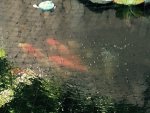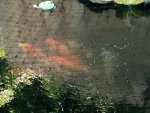If you have ever been seriously into aquarium keeping you'll know that water changes are very beneficial for the quality of your water and health of your fish. However with ponds things get a little different. First of all, as Addy touched on, unlike most aquariums ponds are outside and can get natural water changes from the weather phenomena called rain. In some areas of the world this can go a long way to taking care of your water changes, but in drier regions the rain they get might not even be enough replace the water loss through evaporation. Which is very true where I live. Of course just replacing water that evaporates is not sufficient to constitute a water change. As water evaporates essentially only pure H2O evaporates and leaves behind all the minerals, calcium and impurities that came with the original water. If this goes on long enough your pond water can get very hard. Evaporation also leaves behind all the waste products produce by the fish and decomposing vegetation including ammonia. nitrites and nitrates. Also fish produce pheromones that they use to communicate with each other. In the wild they use these pheromones as a way of finding or avoiding each other (for instance in mating), but in the confines of a heavily stocked pond a concentrated pheromone build up can have a very detrimental effect on the fish.
So turning over water (water changes) is a good thing, and helps simulate their natural environment, however as Jordan brought up, if done improperly it can stress fish as well. That's why I advocate the drip water changes system as it is the safest and easiest way to change your water, with zero stress on the fish and no need for dechlorinating chemicals.
So turning over water (water changes) is a good thing, and helps simulate their natural environment, however as Jordan brought up, if done improperly it can stress fish as well. That's why I advocate the drip water changes system as it is the safest and easiest way to change your water, with zero stress on the fish and no need for dechlorinating chemicals.



